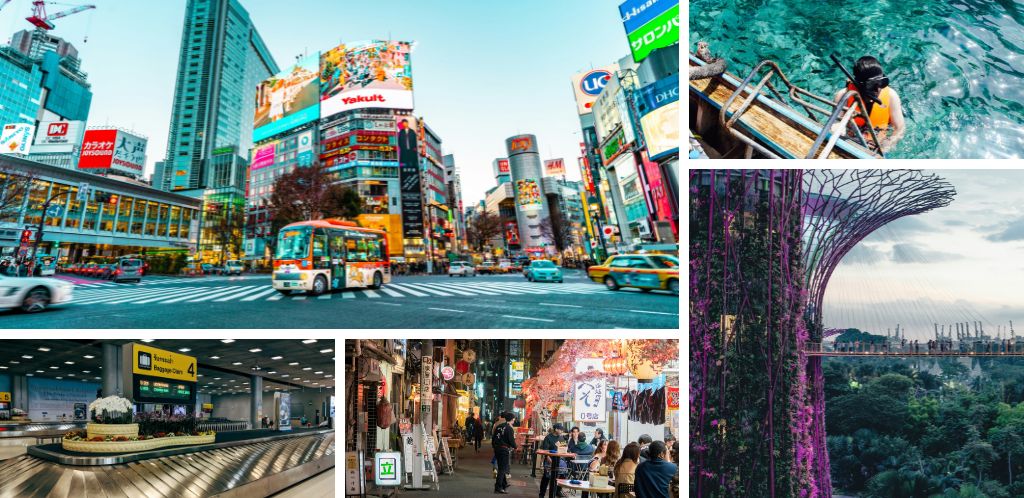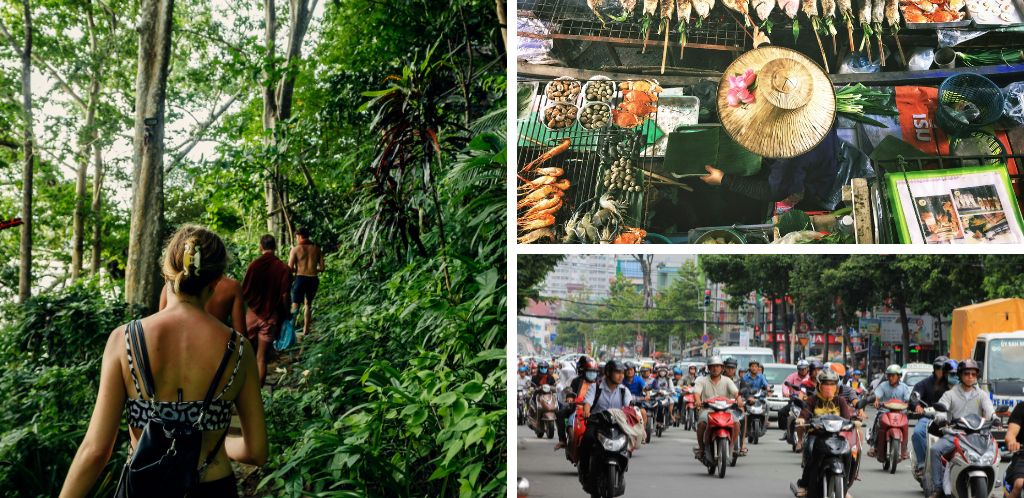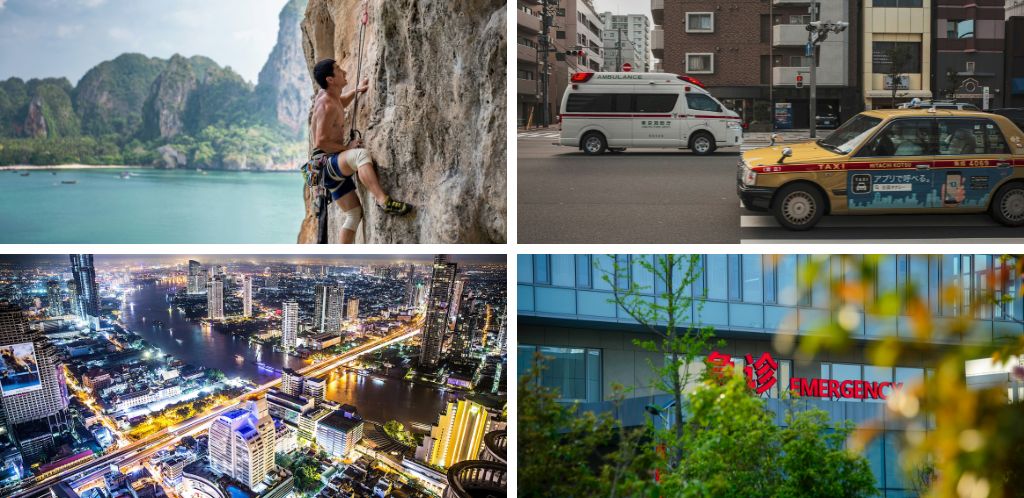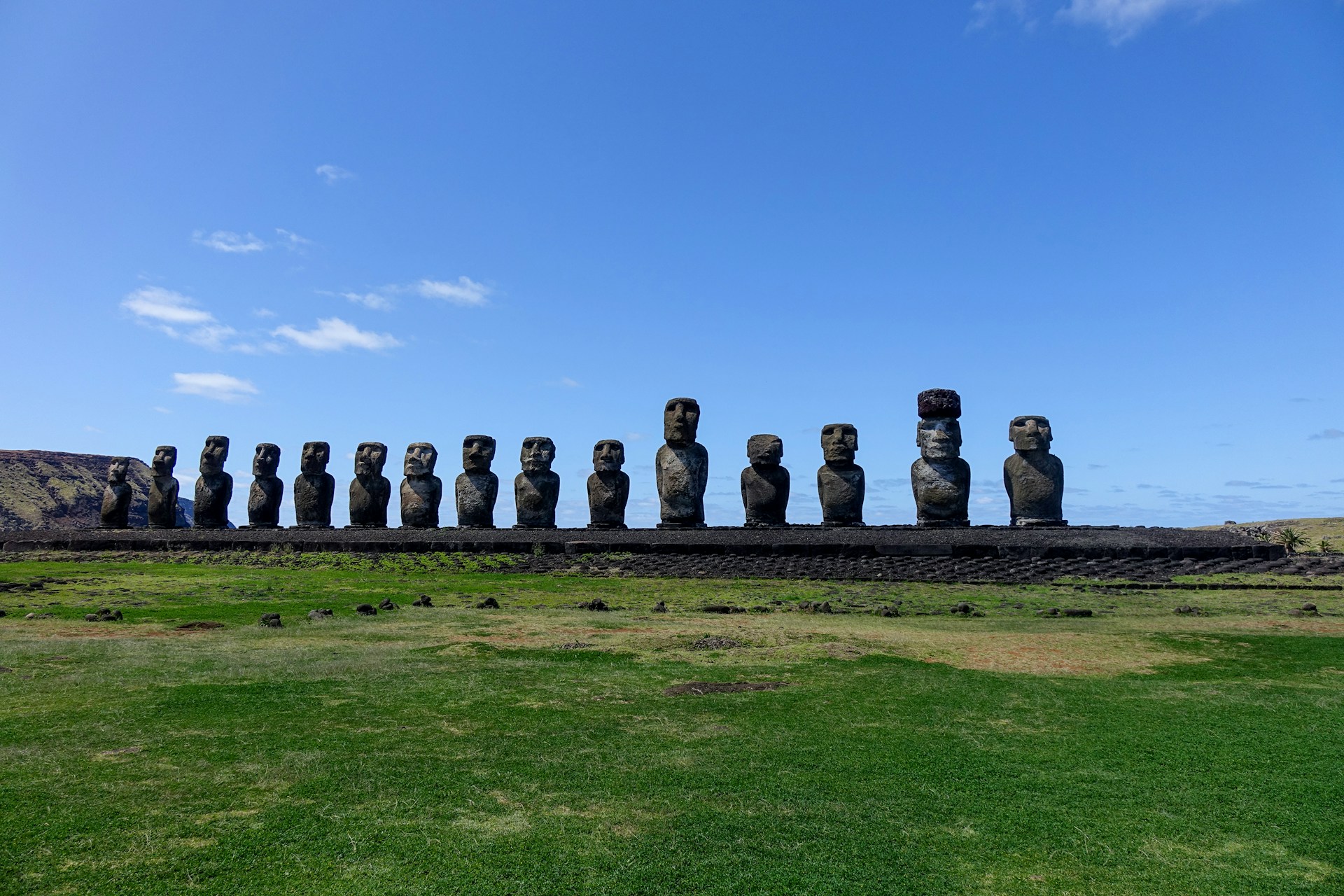Travel insurance for Asia: Which should we choose?
Planning a trip to Japan, Thailand or any other Asian country? We'll tell you which is the best travel insurance for Asia. Travel protected!
Thinking of traveling to Vietnam, Singapore, or another country in Asia? Maybe you’re planning to visit a few different places? Asia is an incredible and diverse continent, but to make the most of your trip, it’s important to be prepared for the unexpected. While you’re sorting out flights, itineraries, and hotels, don’t forget to take some time to secure reliable travel insurance for Asia.
That’s exactly what we want to talk about in this article. To help you find the best insurance for your needs, we’ll go over the coverage options offered by the most popular providers for this continent, as well as their prices. Keep reading to learn how to protect your health and your belongings during your Asian adventure!
Why take out travel insurance for Asia?

Getting travel insurance isn’t just a precaution. It’s an investment to help avoid bigger problems, especially when visiting a diverse destination like Asia.
If you have a medical issue, you’ll want an insurance company that’s experienced in handling hospital and clinic claims quickly and efficiently. This can save you time and money. In countries like Japan or Singapore, while the hospitals are top-notch with cutting-edge technology, the costs can be a shock. For example, a simple consultation in Japan can cost around 20,000 yen ($125), and a single night’s stay could easily go over 100,000 yen ($670). In Singapore, a hospital stay might cost more than 1,000 Singapore dollars ($730).
In Southeast Asian countries like Thailand and Vietnam, private clinics are often the most reliable option, particularly in rural areas. A visit to a private hospital in Thailand can cost anywhere from 1,500 to 5,000 baht ($40 to $130). For more serious emergencies, such as surgery or an emergency evacuation, the expenses can quickly become much higher.
Planning to visit places like Cambodia, Indonesia, or the Philippines? If so, you should be aware that tropical diseases, like dengue or malaria, are common in these areas. Medical treatments for these conditions can cost up to 100,000 Philippine pesos ($1,760).
The challenges you might face go beyond just health concerns. Many travelers have dealt with lost luggage at busy airports like those in Bangkok or Jakarta. With the right insurance, you’ll be able to replace your items without blowing your entire travel budget.
Natural disasters are probably the last thing on your mind when planning a trip to Japan or anywhere else. But the reality is that travelers in Asia have occasionally faced typhoons, earthquakes, and floods. Having travel insurance can help cover cancellations, itinerary changes, and unexpected expenses if something like this happens.
What should a travel insurance for Asia cover?
If you’re new to picking the right travel insurance, all the options and unfamiliar terms can feel overwhelming. The coverage you need will depend on your travel plans and destinations—after all, expenses in Tokyo or Singapore are vastly different from those in Vietnam. That means your insurance should be tailored accordingly. However, there are a few key things that any good travel insurance for Asia should include. Here are the most important ones:

- Emergency medical care. The quality of medical care can vary greatly between countries like Japan, Thailand, and Vietnam. That’s why it’s essential to have travel insurance with at least $27,700 in medical coverage. This should include doctor visits, hospital stays, medications, and even emergency transportation. Also, make sure your policy covers treatment for tropical diseases like dengue, malaria, and typhoid fever, which are common in Southeast Asia.
- Health or death repatriation. Medical evacuations from Asia to your home country can cost over $100,000. If you’re traveling to remote areas—like the Himalayas or isolated islands in Indonesia—having insurance that includes repatriation is a must. This coverage also extends to worst-case scenarios, such as returning your remains in the event of death. Fortunately, most travel insurance plans include repatriation as a standard benefit.
- Adventure sports coverage. Many travelers in Asia take part in adventure sports, whether it’s scuba diving in the Philippines, trekking in Nepal, or surfing in Bali. If you’re planning any of these activities, make sure your insurance covers them, as many basic policies don’t include adventure sports.
- Loss or theft of luggage. Your insurance should provide financial compensation to replace essentials like clothing, electronics, and other valuables in case your luggage is lost or stolen. A coverage limit of around $720 is a good benchmark for peace of mind.
- Flight delays and cancellations. Flight delays are pretty common in Asia, especially on domestic routes and trips to remote islands. A solid travel insurance plan should help cover extra costs like accommodation, meals, and transportation if your plans get disrupted. Aim for a policy that offers around $130 per day to keep unexpected expenses from piling up.
- Legal assistance at destination. While it’s often overlooked, having legal coverage can be incredibly helpful if you run into legal trouble. It’s reassuring to know you can rely on someone if you’re involved in a car accident in Thailand or a rental dispute in Japan. Your insurance should cover lawyer fees and, if needed, the cost of translating legal documents.
- 24/7 service and support. Traveling through Asia often comes with time zone challenges and language barriers. Your insurance should provide 24/7 support, preferably in your own language. Many companies offer apps that make it simple to manage claims or get in touch with doctors whenever necessary. And be sure to grab a Holafly eSIM so you can easily get help whenever you need it.
Important: If you are a frequent traveler and want to stay connected without worrying about expensive roaming or looking for a new SIM at every destination, Holafly’s subscription plans are for you. With a single eSIM, enjoy internet in more than 170 countries for a fixed price and no surprises on your bill. travel without limits and connect easily and securely! 🚀🌍

Comparison of the best travel insurances for Asia
Now that you know why it’s important to travel with insurance and have a sense of what to look for in a policy, let’s move on. We’ll review some of the top travel insurance for Asia in 2025. We’ve chosen these five based on their coverage, reputation, and the experiences of other travelers who have used them for trips to Asia. To help you get a clearer picture of what they offer, we’ve created a table with the most important information.
| Coverage | Chapka (CAP TRIP Basic) | HeyMondo (Travel Tranquility) | IATI (Backpacker) | AXA Assistance (Total) | Intermundial (Totaltravel Mini) |
| Price (7 days) | 26,76 euros ($28,90) | 35,59 euros ($38,49) | 53,99 euros ($57) | 58,07 euros ($62,80) | 33,31 euros ($36,10) |
| Medical expenses | 250,000 euros ($269,946) | 600,000 euros ($648,837) | 500,000 euros ($540,697) | 150,000 euros ($162,209) | 300,000 euros ($325,083) |
| Repatriation | Unlimited | Unlimited | Unlimited | Unlimited | Unlimited |
| Loss or theft of baggage | 800 euros ($865) | 1,500 euros ($1,622) | 1,500 euros ($1,622) | 1,500 euros ($1,622) | 1,500 euros ($1,622) |
| 24/7 assistance | Yes | Yes | Yes | Yes | Yes |
| Trip cancellation | Optional | Optional | Optional | Optional | Optional |
| Coverage of adventure sports | Yes | Yes | Yes | Optional: Sports insurance ($34) | No |
| Civil liability | 40,000 euros ($43,191). Franchise 150 euros ($162) | 60,000 euros ($64,883) | 60,000 euros ($64,883) | 30,000 euros ($32,441) | 50,000 euros ($54,180) |
| Compensation for flight delay | Only at the beginning of the trip, up to 150 euros ($162) | 300 euros ($324) | 270 euros ($291) | 150 euros ($162) | 150 euros ($162) |
Top 5 travel insurances for Asia
As you can see from the table above, there are clear differences in both prices and coverage between the policies. You’ll also find variations in customer service and the network of hospitals and clinics they cover. Let’s dive deeper into what each company offers so you can get a better idea of your options and pick the best travel insurance for your trip to Asia.

IATI
IATI is one of the most well-known insurance providers in Europe, with over 135 years of experience protecting all kinds of travelers. Their plans are especially popular among those looking for flexibility and personalized service—key features for a diverse destination like Asia. With IATI, you can easily manage claims through their mobile app, which offers features like online medical consultations and finding nearby hospitals. Plus, their customer service is available 24/7, making it perfect for travelers who need clear and prompt assistance, no matter the time zone.
IATI offers travel insurance plans tailored for those visiting Asia, whether it’s for long trips, adventure activities, or family vacations. Their policies provide extensive medical coverage, guaranteed repatriation, and protection against unforeseen issues like delays or lost luggage. A highlight is the IATI Backpacker plan, ideal for those exploring several countries in the region, as it includes extra coverage for adventure sports and legal support.
Main coverage:
- Medical expenses: From 100,000 euros ($109,000) for IATI Basic to 5,000,000 euros ($5,400,000) for IATI Star.
- Repatriation: 100%.
- Loss of luggage: 500 euros ($540) in the basic insurance, 2,500 euros ($2,710) in the Star insurance.
- Adventure sports coverage: Included in premium plans. For whitewater, canyoning, rafting, cross-country skiing and other risky sports, you’ll need to take out the “Premium Adventure” clause in any plan.
- Reimbursement for delays: 300 euros ($325) in the IATI Star insurance.
Plans and prices:
- IATI Backpacker: 53,99 euros ($58,39) for 7 days.
- IATI Basic: 32,90 euros ($35,58) for 7 days.
- IATI Standard: 38,88 euros ($42,05) for 7 days.
- IATI Star: 70,87 euros ($76,64) for 7 days.
| Advantages | Disadvantages |
| 24/7 customer service in Spanish | More limited coverage on basic plans |
| No need to advance expenses in medical emergencies | High prices on premium options |
| Easy to use and efficient app | Trip cancellation not included in all plans |
HeyMondo
HeyMondo has become one of the most modern and innovative options in the travel insurance market. Their focus is on user convenience, offering a mobile app that makes it easy to manage claims, book medical consultations, and request reimbursements quickly. With customer service available 24/7, it’s perfect for handling issues in destinations with language barriers, like China or Japan.
This insurance provider offers a range of plans for Asia, with options ranging from basic coverage to premium policies that include adventure sports and trip cancellations. One of the standout features of HeyMondo is its flexibility, allowing travelers to tailor coverage to their specific needs.
Main coverages of HeyMondo travel insurance in Asia:
- Medical expenses: Up to 600,000 euros ($648,837) in “Tranquility Travel” and 10,000,000 euros ($10,796,250) in “Premium Travel”.
- Repatriation: Unlimited.
- Lost or stolen baggage: Up to 1,500 euros ($1,622) for the Tranquility fare and 3,500 euros ($3,778) for the Premium fare. Up to 2,500 euros ($2,700) on the Top Travel fare.
- Adventure sports: Included in the Complete rate.
- Liability: 60,000 euros ($64,883).
Plans and prices:
- Essential Trip: 30,55 euros ($33,03) for 7 days.
- Tranquility Trip: 35,59 euros ($38,48) for 7 days.
- Top Trip: 57,18 euros ($61,82) for 7 days.
- Premium Trip: 76,01 euros ($82,18) for 7 days.
| Advantages | Disadvantages |
| Mobile app for immediate incident management | More limited coverage on basic plans |
| Extensive medical coverage in premium plans | High prices on premium options |
| 24/7 personalized attention in Spanish | Trip cancellation not included in all plans |
Chapka
Chapka is a French insurer known for catering to travelers looking for unique adventures. Since 2002, it has been offering flexible plans tailored to more adventurous profiles, like backpackers or extreme sports enthusiasts. With a focus on high-risk activities and Spanish-speaking customer support, it’s a favorite among travelers heading to places like Thailand, Nepal, or Indonesia. Their global assistance network also ensures you get help, even in the most remote locations.
They offer several plans tailored for travel in Asia. The Cap Trip Basic is the most popular, as it provides essential coverage at competitive rates. For those looking for extra security, the Cap Trip Plus includes added benefits like trip cancellation and higher medical expense limits. Both plans also cover adventure sports and repatriation.
Main coverage of travel insurance for Asia Chapka:
- Medical expenses: Up to 250,000 euros ($269,946). In advanced plans, 1,000,000 euros ($1,081,395), also emergencies and hospitalizations.
- Repatriation: Included.
- Loss or theft of luggage: Up to 800 euros ($865). Plans above 2,500 euros ($2,703).
- 24/7 assistance: Medical assistance at any time.
- Adventure sports coverage: Includes sports such as diving, surfing or kitesurfing.
- Flight delay: Only at the beginning of the trip, up to 150 euros ($162). In higher plans up to 1,500 euros ($1,622).
Plans and prices:
- Cap Trip Plus: 35,59 euros ($37) for seven days.
- Cap Basic: 26,76 euros ($28) for seven days.
| Advantages | Disadvantages |
| Adventure sports coverage at no additional cost | Lower medical limits than other premium options |
| Competitive pricing for full coverage | Limited cancellation coverage in the basic plan |
| 24/7 customer service in Spanish | Less customization in advanced policies |
InterMundial
Founded in Spain in 1994, InterMundial is an insurance provider known for offering versatile solutions that suit different types of trips and budgets. With its experience in the travel industry and Spanish-speaking customer service, it’s a trusted choice for travelers looking for peace of mind in diverse destinations like Japan, Vietnam, or Malaysia. Additionally, their online platform and app make it easy to manage claims quickly and efficiently.
The Totaltravel Mini is their most budget-friendly plan, ideal for those who just need basic coverage. For more comprehensive protection, the Totaltravel Premium increases limits on medical expenses, liability, and trip cancellation. This makes InterMundial a great choice for both short getaways and extended stays in Asia. One of the most appreciated aspects of InterMundial is the flexibility of their plans, allowing you to adjust coverage dates if your trip is delayed.
Main coverages:
- Medical expenses: Up to 300,000 euros ($325,000) in the TotalTravel mini plan, up to 2,500,000 euros ($2,700,000) in the Totaltravel premium plan. The Totaltravel plan covers up to 1,000,000 euros ($1,100,000).
- Repatriation: Unlimited in all plans.
- Loss of luggage: Up to 1,500 euros ($1,625) in the most basic plan; 2,500 euros ($2,710) in the TotalTravel plan and up to 3,200 euros ($3,470) in the Premium plan.
- Liability: Up to 80,000 euros ($80,700) in the Totaltravel plan and up to 100,000 euros ($108,00) in the Premium plan.
InterMundial’s Asia travel insurance plans and prices:
- Totaltravel mini: 33,31 euros ($35) for seven days.
- Totaltravel: 41,74 euros ($43) for seven days.
- Totaltravel premium: 65,78 euros ($67) for seven days.
| Advantages | Disadvantages |
| Extensive medical coverage in premium plans | Adventure sports not included in basic plans |
| Flexibility in cancellations and rescheduling | Higher prices on premium options |
| 24/7 customer service in Spanish | Limited lost luggage coverage on basic plans |
AXA Assistance
AXA Assistance is a highly reputable insurance provider with a strong international presence. What makes them stand out is their global support network, offering reliable coverage wherever you are in Asia.
Their plans are tailored to offer fast, high-quality medical emergency support, with the ability to customize coverage based on the type of trip. The Mini Insurance is great for short stays, while more comprehensive options like Total Plus Insurance provide extended medical coverage, protection for lost luggage, and the option to add adventure sports coverage.
AXA’s Asia travel insurance main coverages:
- Medical expenses: Up to 150,000 euros ($162,209).
- Repatriation: Unlimited.
- Luggage loss or theft: Up to 1,500 euros ($1,622).
- Adventure sports: Additional option ($35).
- Civil liability: 30,000 euros ($32,441).
Plans and prices:
- Mini Insurance: 37,65 euros ($40,82) for seven days.
- Total Insurance: 58,07 euros ($62,80) for seven days.
- Total Plus Insurance: 80,28 euros ($86,81) for seven days.
| Advantages | Disadvantages |
| Extensive global support network | Lower basic medical coverage than other premium options |
| Fast and efficient emergency care | Adventure sports require an additional cost |
| Customizable plans for all types of travelers | Higher prices on advanced plans |
What is the best travel insurance for Asia?
Still unsure? If you need a little more guidance in making your decision, after carefully reviewing the top insurance providers and their policies, one stands out as the best choice for traveling to Asia: IATI.
What sets it apart is its fast emergency response, user-friendly app, and a wide range of policies. Depending on the area of Asia you’re visiting, you’ll want to select the plan that fits your needs.
- IATI Backpacker: Ideal for Southeast Asia and destinations where outdoor activities and rural environments predominate.
- IATI Star: Perfect for Japan, South Korea or Singapore, where the cost of medical care is high and travelers need more premium coverage.
If you’re planning a long journey through Southeast Asia and other destinations with a higher cost of living, IATI Star is the way to go. It offers comprehensive medical coverage for countries with higher healthcare costs, and its financial compensation is ideal for trips with lots of internal flights. And if you’re planning on doing adventurous activities, make sure to add the “Premium Adventure” option!
By now, you should have a better idea of how to choose the right travel insurance for your trip to Asia. Take a close look at each insurer’s terms and think about your specific needs before making your decision. Looking for more travel tips? Browse through our blog for helpful guides on picking the best eSIM for Asia and articles on what to do in Thailand and other Asian destinations.





 Language
Language 


















 No results found
No results found







